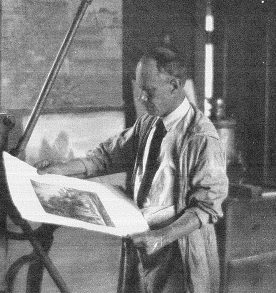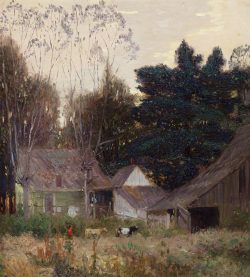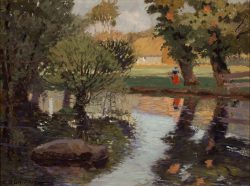L. O. Griffith at his etching press, from an undated photograph reproduced in Lyn Letsinger-Miller, The Artists of Brown County (Bloomington and Indianapolis: Indiana University Press, 1994), 92.

L. O. Griffith 1875–1956
Louis Oscar Griffith was born in Greencastle, Indiana, and as a child moved with his family to Dallas, Texas. While working there as a hotel clerk, he began taking art lessons in the studio of landscapist Frank Reaugh, who became his lifelong mentor. Griffith left Dallas in 1893 to continue his studies at the Saint Louis School and Museum of Fine Arts (now the Saint Louis Art Museum), and in 1895 he moved to Chicago to work as a commercial artist while attending evening classes at the Art Institute of Chicago. Hired by the Barnes-Crosby Engraving Company in Chicago in 1897, Griffith soon developed an interest in etching, in which he was largely self-taught. His work took him to New York in 1902.
On his return a year later, Griffith made his debut as a painter in the Art Institute’s sixteenth annual American art exhibition. He also joined the Palette and Chisel Club, of which he remained an active member throughout his time in Chicago, and he became a charter member of the Chicago Society of Etchers, founded in 1910. In 1905, Griffith took the first of several sketching expeditions through Texas with Reaugh. On these trips he honed his landscape technique and painted sketches; these would form the basis for the numerous paintings and prints by which his name became synonymous with the depiction of the state’s vast open lands. In 1907, Griffith broadened his subject matter as he joined the first wave of Chicago artists to work in Brown County, Indiana; that year, he also painted in coastal Maine. In 1908, Griffith visited France and England not only to paint but also to perfect his skills in techniques of color intaglio printmaking. In 1916 he visited New Orleans.
In Chicago, Griffith received enthusiastic praise for his works in oil, pastel, and watercolor presented in solo exhibitions at the Artists’ Guild in 1914 and at the Palette and Chisel Club in 1915 and 1920. His reputation as a printmaker was equally strong, particularly when a group of his color aquatints earned a bronze medal at the 1915 Panama-Pacific International Exposition in San Francisco. Griffith still supported himself with commercial work, however, making the relatively accessible Brown County a more attractive destination than Texas. With his marriage in 1920 and the birth of a son, the artist relocated with his family to Nashville, Indiana, the center of the Brown County art colony. He became active in the Hoosier Salon, an annual display in Chicago for artists working in Indiana, and he won several awards in its shows between 1925 and 1949.
In 1926, the Highland Park Gallery, in a suburb of Dallas, staged an exhibition of Griffith’s oil paintings, etchings, and color aquatints. His visit to the city of his youth, now much changed, inspired Griffith to create a series of etched views of modern Dallas, and he established a winter studio there. Regarded as the city’s most important etcher, he supported his landscape painting through sales of his prints. Griffith continued exhibiting work in both mediums until his last decade.
Wendy Greenhouse, PhD

